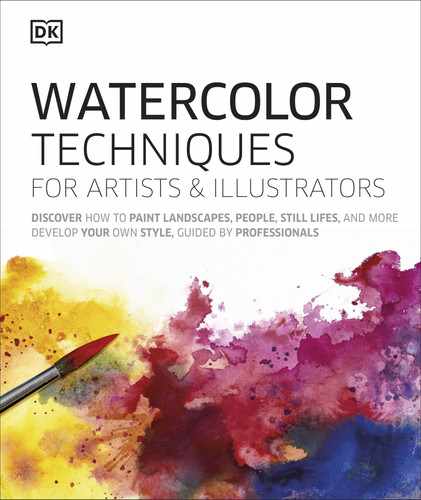
190 Landscapes and townscapes | SUBJECTS
Colors
in snow
PAINTING WHITE USING COLOR
Like other white subjects, snow reects
the colors around it. The key is to identify
the light and shadow patterns, breaking the
scene down into light, medium, and dark
tonal values, and looking for colors to
convey the snowy atmosphere.
Using color and tone
The appearance of snow is inuenced by the colors
of the surrounding objects and light sources. Look
for tonal color changes in shadows to describe
snowy shapes, and observe the effects of perceived
temperature where cool shadows are contrasted
against a patch of warm sunlight.
1
Tonal study
Simplify your scene into a tonal study using charcoal. Note the
shapes created by the areas of light, mid, and dark tone. Transfer
these areas to your paper in a pencil sketch to guide your washes.
PUTTING IT INTO PRACTICE
The feeling of light in the snowy scene is created
through the dramatic contrast between the dark
creek and the white snow. The warm, late afternoon
sunlight and cool shadows enhance the drama.
Shadow colors
In general, shadows on
snow will reect the sky.
A clear sky will produce
blue snow shadows,
compared to dull tones
of an overcast scene.
Temperature contrasts
Use contrasts in color
temperature (see pp.34–35)
to convey the literal chill of
the shadows, where large
areas of cool blue are
juxtaposed against patches
of warm orange or yellow.
Selection of hake brushes
1
⁄2 in (13 mm) and
1
⁄4 in (6 mm)
synthetic at brushes
Selection of soft-hair mop
and round brushes
Vine charcoal
11 x 14 in (28 x 36 cm)
hot press 140 lb (300 gsm)
watercolor paper
You will need
Snowy creek
Use tonal variations of blue
for shadows on sunlit snow
Azo yellow
Phthalo blue
Alizarin
crimson
Burnt umber
Cadmium
orange
Payne’s gray
Cobalt blue
Cobalt green
Cadmium
red
Ivory black
Cerulean blue
Quinacridone
magenta
Chinese white
Cadmium
yellow
Dioxazine
violet
Ultramarine
blue
Cobalt teal
US_190-191_Snow_1.indd 190 02/04/2020 3:35pm

2
Light and mid tones
Start with the light tones, adding the warm
yellow of the sunlit snow to wet paper to give
soft edges. Block in the mid values of the
shadows and background, with varied tones.
4
Warm and cool contrasts
Add warm yellows and orange where the
sun breaks through and hits the snow. Outline
the blue shadow edges with yellow; the stark
contrast makes the shadows appear colder.
3
Dark tones
Next, ll the areas of darkest tone in the
creek and the distant tree trunks. The stark
contrast between dark and light edges helps
throw the snowy bank forward.
US_190-191_Snow_1.indd 191 02/04/2020 3:35pm
..................Content has been hidden....................
You can't read the all page of ebook, please click here login for view all page.
